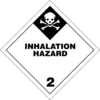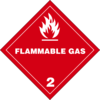Carbon monoxide, refrigerated liquid (cryogenic liquid)
Carbon monoxide (chemical formula CO) is a poisonous, flammable gas that is colorless, odorless, tasteless, and slightly less dense than air. Carbon monoxide consists of one carbon atom and one oxygen atom connected by a triple bond. It is the simplest carbon oxide. In coordination complexes, the carbon monoxide ligand is called carbonyl. Wikipedia
Substance Data
Source: TOXNETCAS-Number630-08-0 |
Flash Pointn/a | Boiling Pointn/a |
| Emergency Response Guide No. ! |
Data from the Hazardous Materials Table
Source: 49 CFR §172 (2018/07)(3) Hazard Class2.3Poisonous gas |
(4) Identification number |
(5) Packing Group |
||||||||
(6) Labels |
||||||||||
(1) Symbols |
||||||||||
| 4 | |
|---|---|
| T75 | |
| TP5 |
(8) Packing Authorizations (§173.***) 
| (8A) Exceptions | None | |
|---|---|---|
| (8B) Non-bulk | 316 | see 49 CFR §173.316 |
| (8C) Bulk | 318 | see 49 CFR §173.318 |
(9) Quantity Limits 
| (9A) Passenger aircraft/rail | Forbidden |
|---|---|
| (9B) Cargo aircraft only | Forbidden |
(10) Vessel stowage 
| (10A) Location | |
|---|---|
| (10B) Other | n/a |
Segregation Chart for Load, Transport, Storage
In this table a statement is contained for each hazard class whether the loading, transport or storage with other hazard classes is allowed, is not permitted or is restricted. The table is based on U.S.-Code 49 CFR §177.848.
Note: In this segregation and separation chart are HazMat of hazard class 2.3 considered depending on their poisonousness by inhalation (Hazard zone A/B). See PHMSA Interpretation #09-0252.
There are no restrictions with hazardous materials, as pointed out in the instructions for using the Segregation Table (see 49 CFR §177.848(e)). But please, refer to following requirements in 49 CFR §177 Subpart B (Loading and Unloading):
- §177.834 - General requirements
- §177.835 - Class 1 materials
- §177.837 - Class 3 materials
- §177.838 - Class 4 (flammable solid) materials, Class 5 (oxidizing) materials, and Division 4.2 (pyroforic liquid) materials.
- §177.839 - Class 8 (corrosive) materials
- §177.840 - Class 2 (gases) materials
- §177.841 - Division 6.1 and Division 2.3 materials
- §177.842 - Class 7 (radioactive) material
- §177.843 - Contamination of vehicles.

